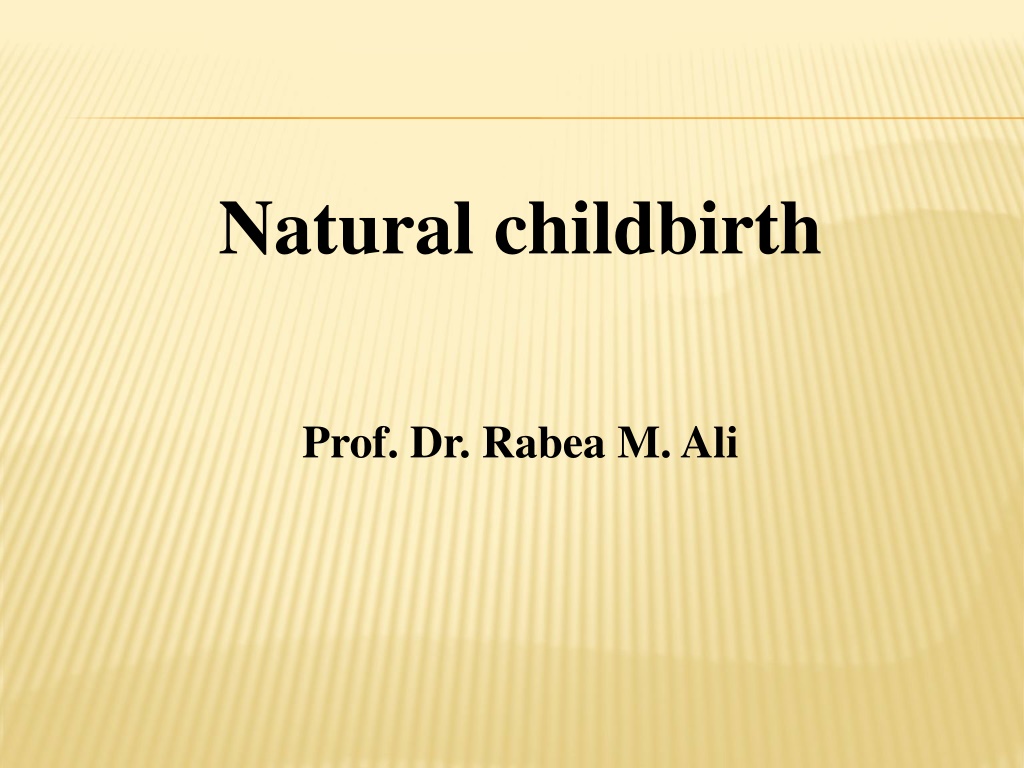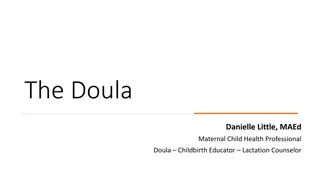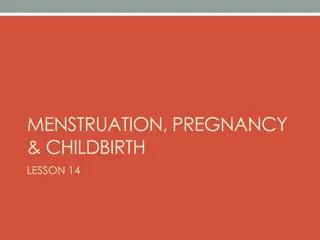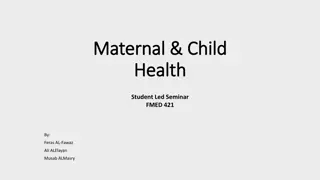Understanding Natural Childbirth and Its Benefits
Natural childbirth is a method of delivery that avoids routine medical interventions, such as anesthesia and surgery. It focuses on minimizing medical intervention to promote a more holistic birthing experience. Women have the freedom to choose their birth setting, whether in a hospital, birth center, or at home, and can utilize various comfort measures during labor. Advocates highlight the health benefits for both mother and child, emphasizing the mother's connection with her body, potential faster recovery, and avoidance of certain medical interventions like epidurals. Movement during labor is encouraged as it can enhance maternal comfort, circulation, and the birthing process.
Download Presentation

Please find below an Image/Link to download the presentation.
The content on the website is provided AS IS for your information and personal use only. It may not be sold, licensed, or shared on other websites without obtaining consent from the author. Download presentation by click this link. If you encounter any issues during the download, it is possible that the publisher has removed the file from their server.
E N D
Presentation Transcript
Natural childbirth Prof. Dr. Rabea M. Ali
Natural childbirth is childbirth without routine medical interventions, particularly anesthesia. Natural childbirth arose in opposition to the techno-medical model of childbirth that has recently gained popularity in industrialized societies. Natural childbirth attempts to minimize medical intervention, particularly the use of anesthetic medications and surgical interventions such as episiotomies, forceps and ventouse deliveries and caesarean sections.
Natural childbirth may occur during a physician or midwife attended hospital birth, a midwife attended homebirth, or an unassisted birth. The term "natural childbirth" was coined by obstetrician Grantly Dick-Read upon publication of his book Natural Childbirth in the 1930s, which was followed by the 1942 Childbirth Without Fear. Some women who choose to deliver in a non-hospital setting such as a birth center, family-centered care, it's also possible to have a more natural childbirth in many hospitals. Some hospitals have birth and at home, women are free to move around during their labor, get in positions that are most comfortable to them, and spend time in the tub or Jacuzzi. The baby is monitored frequently, often with a handheld ultrasound device. comfort measures such as hydrotherapy, massage, warm and cold compresses, and visualization and relaxation techniques are often used.
The woman is free to eat and drink as she chooses. A variety of health care professionals may work in the birth center setting such as registered nurses, certified nurse midwives, and doulas (professionally trained providers postpartum care) who act as labor assistants. of labor support and/or Advantages natural childbirth 1- Advocates of natural birth suggest this method of delivery is healthier for both the mother and child. There won't be any drugs that could potentially cause harm to the baby. 2- The mother will be able to stay in tune with her body. She will stay alert and aware of every moment of the birth.
3- The mother's recovery time is potentially reduced, and she will generally feel great shortly after the birth. 4- Avoid Interventions childbirth Such as (a small amount of anesthetic is injected into the epidural space that surrounds the spinal cord which lead to side effects. Common epidural side effects include a drop in blood pressure and fever. Births also take longer when an epidural is used, and it may make it more difficult for some babies to get into the best position for birth. 5- Lets Move Around Freely: research shows that unrestricted movement during labor allows the mother to find a position that s more comfortable for her. It s been found to decrease maternal pain, facilitate maternal and fetal circulation, increase the quality of uterine contractions, and facilitate fetal descent. Pain helps mother when it s time to change positions so baby can continue down the birth canal. It also helps her know when it s time to push, and when to stop pushing to avoid a tear.
6- Allows Eat and Drink: Research from the American College of Nurse-Midwives indicates that the lack of nutritional support during labor can cause maternal dehydration, ketosis, hyponatremia and increased maternal stress. 7- Gets Your Partner Involved: According to a 1999study published in Midwifery, support provided by the male partner during childbirth evoked very positive responses from the women participants. 8-Improves Baby s Gut: Researchers at Columbia University suggest that disrupting the mother-to-newborn transmission of bacteria by C-section delivery may increase the risk of celiac disease, asthma, type 1 diabetes and obesity in the child. 9- Initiates Breast-Feeding More Easily: An infant may be impacted by labor and birth medications in a way that impairs launching breast-feeding.
10-Studies by the World Health Organization found that skin-to- skin contact between mothers and babies after birth reduces crying, improves mother-infant interaction, and helps mothers to breastfeed. 11- Passing through the birth canal in a natural birth also helps shape the head and expel amniotic fluid from the lungs which lower baby s risk for respiratory problems like asthma. Babies receive protective bacteria from the birth canal that helps build their immune system. while Babies born via cesarean birth are more likely to pick up bacteria that is on skin, mostly harmful bacteria like staph.
Techniques of Natural Childbirth Include: 1- Lamaze Method (massage, relaxation techniques). 2- Bradley Method (the effective involvement of the husband, relaxation therapy). 3- Alexander Method (breathing exercises, developed a technique for sitting, standing and moving with safety). 4- Hydrotherapy Method (Water Delivery) 5- Other approaches include movement, walking, and different positions (for example, using a birthing ball), hot and cold therapy (for example, using hot/ or cold packs). 6- Birth positions favored in natural childbirth including squatting, lithotomy position (woman in hospital bed on her back with legs in stirrups).
Lamaze Method The Lamaze technique, also known as the psycho prophylactic method or simply Lamaze, started as a prepared childbirth technique popularized in the 1940s by French obstetrician Dr. Fernand Lamaze based on his observations in the Soviet Union as an alternative to the use of medical intervention during childbirth. Today, Lamaze has become a popular way to get information about pregnancy, birth, and parenting through Lamaze International.
The stated goal of Lamaze is to increase a mother's confidence in her ability to give birth; classes help pregnant women understand how to cope with pain in ways that both facilitate labor and promote comfort, including relaxation techniques, movement and massage. The beliefs of Lamaze International can be summarized with their Six Healthy Birth Practices 1- Let labor begin on its own 2- Walk, move around and change positions throughout labor 3- Bring a loved one or friend for continuous support 4-Avoid interventions that are not medically necessary. 5- Avoid giving birth on your back and follow your body's urges to push. 6- Keep mother and baby together - It's best for mother, baby and breastfeeding.
Bradley Method The Bradley method of natural childbirth (also known as "husband coached childbirth") is a method of natural childbirth developed in 1947 by Robert A. Bradley, The Bradley method emphasizes that birth is a natural process: mothers are encouraged to trust their body and focus on diet and exercise throughout pregnancy; and it teaches couples to manage labor through deep breathing and the support of a partner. The main goal of the Bradley method is healthy mothers and babies.
Bradley entered into obstetrics in 1947; at the time mothers were restrained in large cribs and wore protective helmets to protect their heads from hitting the sides of the crib due to the effect of the medication they were given. The method Bradley termed "the six needs of the laboring woman most notably. deep and complete relaxation abdominal breathing, but also including quiet, darkness and solitude, physical comfort, closed eyes and the appearance of sleep
Alexander Method The Alexander Technique is an educational method used worldwide for over 100 years. By teaching how to change faulty postural habits, it enables improved mobility, posture, alertness and relief of chronic stiffness, tension and stress. The Alexander Technique is so far helpful for long-term back pain, long-term neck pain, and may help people cope with Parkinson's disease. The Alexander Technique is a method of muscular re-education, which has become standard training for actors, dancers and singers, and is practiced for health reasons all over the world.
Water Delivery Giving birth in a warm tub of water can help a woman relax. The buoyancy also helps alleviate discomfort and pressure. Some believe that the water helps the baby enter the world with less light, sound, and dramatic change. Water delivery is not recommended for women with high-risk pregnancies and in every case preparation should be made for delivery to occur out of the water if complications arise. recommended and there places overseas where continuous under water equipment for fetal monitoring is available.
The natural childbirth they have certain basic principles in common. 1- The father or a trusted companion attends the classes with the mother. During labor and delivery this companion is with the mother to encourage and coach her. 2- The mother is taught certain exercises, usually related to breathing and to bearing down, which she uses during contractions and delivery. 3- In the classes, which are usually attended during the latter half of pregnancy, the mother and her companion are taught the principles of labor and delivery. Attempts are made to correct misconceptions, to allay fears, and to make childbirth a fulfilling experience for both the mother and father.
Natural pain relief options Without Medication: 1-Relaxation. 2- breathing. 3-moving around. 4- water therapy. 5- massage With medication: Spinal anesthesia and Epidural analgesia Methods of natural pain relive 1-walking around 2-sitting / rocking on a birthing (exercise)ball 3- taking a hot shower (aimed at your low back)or a Jacuzzi 4-massaging your back (well, have someone else do it) 5-sitting up and rocking
6-counter pressure on the back (especially for back labor). Try tennis balls. 7- massage oils for all-over massage 8-chiropractic adjustment (some will make house calls) 9-prayer / meditation, yoga 10-focusing on the baby and opening 11-changing positions 12- soothing music 13- foot massage(pressure points, can take your mind off the pain) 14-getting in a pool of water 15 staying hydrated 16- eating small snacks, if you want to
steps to preparing for a natural childbirth: Step 1: Commit Most women don t just stumble into a natural birth. It takes determination and commitment. Birth never happens exactly how you plan, so it s good to be open to changing plans when need be. However, going into labor without fully committing to an un medicated birth will make it hard to resist when the going gets tough and nurses are offering medication. Step 2: Prepare your mind and body Labor is a very physical journey, exercise will help keep you strong. Walking, swimming, and yoga are great ways to prepare for birth by keeping your body strong and pelvis open. belly mapping, daily stretching and exercise, prenatal yoga, and just getting up and walking around every so often when you re at work. It s also important to avoid sitting in reclined positions like in big comfy chairs and sofas. Sitting on a birth ball is a great alternative.
Eat while pregnant is creating the baby, so its vital to eat a high nutrient, real food diet. Be sure to eat enough quality protein, salt, and vegetables. Choose foods from different color groups (called eating the rainbow) so you can be sure you are getting what you and baby need. Labor is also a mental, emotional, and spiritual journey. Many women have found that practicing mindfulness, prayer, or daily affirmations help them connect to their baby and prepare mentally for the experience together. Step 3: Get a Doula A doula is a professionally trained birth attendant who will meet with you throughout your pregnancy to establish a relationship, she ll be with you and coach you throughout your entire labor, and will follow up with breastfeeding and newborn care. Doulas are seriously birth angels. Women who have doulas are more likely to have spontaneous vaginal births . birth they are going to
Step 4: Pick your provider When choosing your provider you have 4 options: OB/GYN Traditional route. These providers are the least likely to be low intervention. Family physician Tend to be more holistic. Will be able to care for you and your baby after birth. Certified Professional Midwives (CPM) Are midwives, not nurses; they re only licensed in some states. Certified Nurse Midwives (CNM) Nurses who have additional midwifery training. Step 5: Pick your birth place Choosing a birth place is just as important as choosing your provider. You have 3 choices. Hospital :A great place for a woman who anticipates needing more interventions. There s a hospital bed, monitors, oxygen, etc. on the walls, fluorescent lights, baby warmer. The hospital is the only place you can have a cesarean or get pain medication
Birth center: A birth center is like giving birth at someone elses home. Birth centers are comfy environments, usually with a large bed, and a warm homey feel. They contain medical equipment, but it s usually hidden away out of sight. Birth centers can provide some interventions but not many,. However, low risk women tend not to need many interventions, and the vast majority of complications during pregnancy and birth come with some forewarning, so emergent transfers are extremely rare. Home: At a home birth, midwives bring the same equipment that is at the birth center. They have a plan for transfer of care in case something comes up during pregnancy or labor. However, transfers are rare. Birth usually happens smoothly on it s own when it s left to just happen. Home birth midwives are skilled at categorizing women as low risk or high risk, so they only take women into their care who are good candidates for home birth.
Step 6: Know the benefit and risk of each intervention You already know that the cascade of interventions is something you want to avoid if possible, but how do you know when an intervention is necessary?























